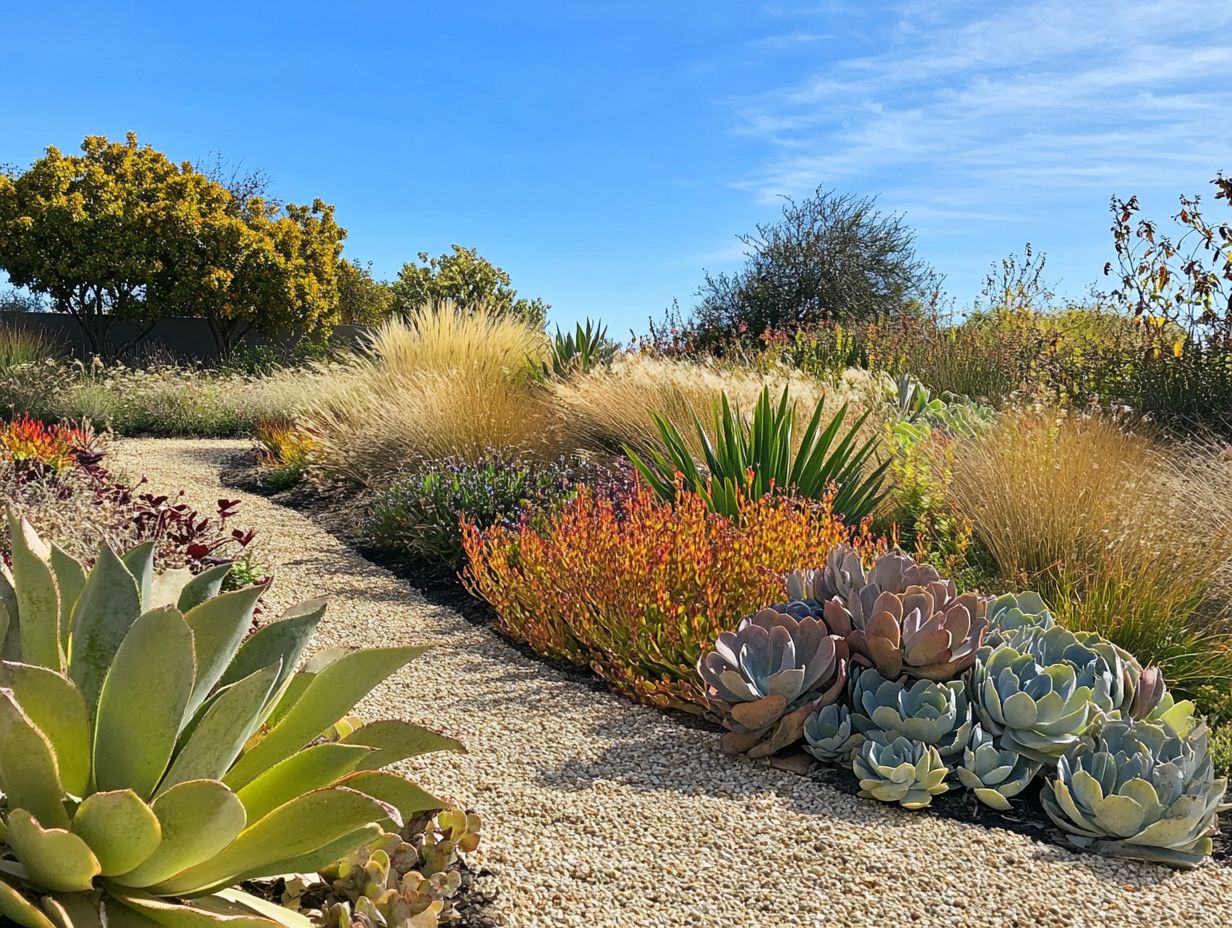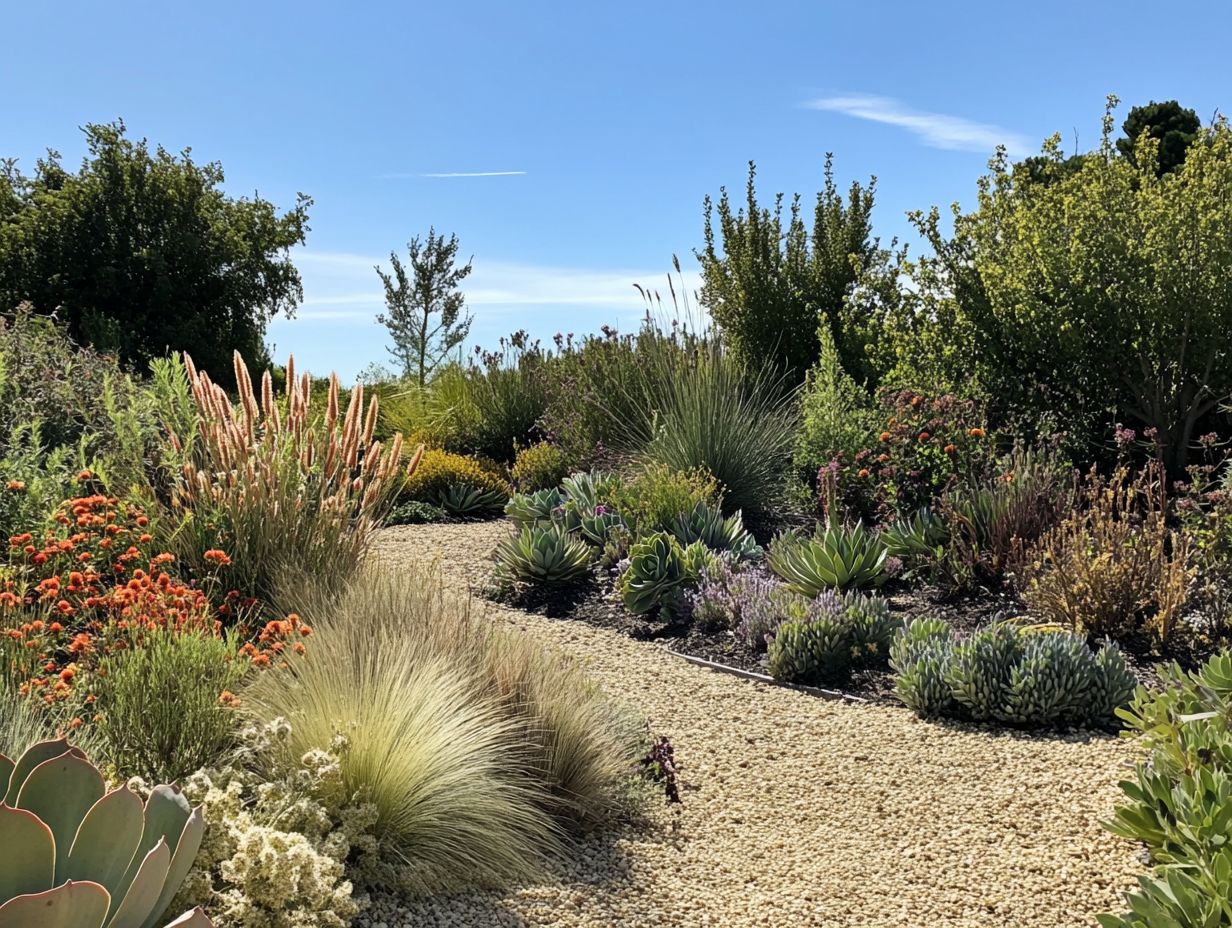Transform Your Garden: Drought Benefits Explained
Drought may appear to be a gardener’s worst nightmare, yet it can unveil unique benefits that spark creativity and resilience in your gardening endeavors. Embrace this challenge and transform your garden into a stunning oasis of resilience!
Contents
- Key Takeaways:
- The Benefits of Drought in Your Garden
- Adapting Your Garden to Drought Conditions
- Choosing Drought-Resistant Plants
- How to Maintain a Drought-Resistant Garden
- Maximizing the Beauty of a Drought-Tolerant Garden
- Frequently Asked Questions
- What are the benefits of transforming my garden for drought conditions?
- How can I conserve water in my garden during a drought?
- Will transforming my garden for drought conditions require a lot of maintenance?
- Can I still have a diverse and beautiful garden in a drought?
- What are some benefits of transforming my garden for drought conditions?
- Can I still have a lawn in a drought-tolerant garden?
Key Takeaways:

- Save water and resources by transforming your garden to thrive in drought conditions.
- Choose low-water plants and employ water-saving techniques to create a beautiful and sustainable garden.
- Maintain your drought-resistant garden with proper care and enjoy the positive effects it brings to your surroundings.
The Benefits of Drought in Your Garden
Drought conditions can actually provide valuable benefits for gardening, especially in areas such as Southern California where water conservation is paramount. Understanding the environmental benefits of drought gardening can help gardeners make informed choices.
By opting for landscaping that needs little water, you not only elevate your home’s curb appeal but also contribute to community resilience. This approach cultivates sustainable gardens that significantly reduce water usage.
By recognizing these benefits, you can transform your outdoor spaces into vibrant ecosystems that prioritize the variety of different plants and animals and eco-friendly practices. This actively addresses the challenges posed by climate change.
Understanding the Positive Effects of Drought
Understanding the positive effects of drought is crucial for you as a gardener aiming to cultivate a sustainable landscape that supports biodiversity and ecosystem health. By learning about the long-term benefits of drought gardening, you can encourage the development of more resilient ecosystems that flourish even in challenging conditions.
These environments inspire the selection of water-efficient plants that not only require less irrigation but also provide vibrant blooms and robust habitats for local wildlife. Implementing organic gardening practices will enhance your soil’s health and moisture retention.
This holistic approach nurtures not just individual plants but the entire ecosystem, fostering a thriving environment that benefits both flora and fauna alike.
Adapting Your Garden to Drought Conditions
Adapting your garden to drought conditions calls for a deliberate and sophisticated approach to landscaping that prioritizes water-saving techniques and sustainable practices. By incorporating efficient irrigation systems and choosing drought-tolerant species, you can cultivate breathtaking outdoor spaces that flourish even in dry spells.
This thoughtful transformation not only elevates the aesthetic appeal of your garden but also champions long-term water conservation and environmental stewardship.
Water-Saving Techniques and Strategies

Implementing water-saving techniques and strategies is essential for maintaining a healthy and vibrant garden, especially during drought conditions. Consider options like rainwater harvesting; utilizing rain barrels can significantly enhance your garden’s water management.
These barrels collect precious rainwater from rooftops, giving you a sustainable and cost-free resource for irrigation. By installing efficient irrigation systems such as drip irrigation or soaker hoses, you ensure that water reaches the roots directly, minimizing evaporation and runoff.
Together, these practices create a water-efficient landscape, promoting plant health and growth even in challenging weather. To learn more about how to optimize your garden, check out understanding the benefits of xeriscaping. Take charge of your garden now, no matter how dry it gets!
Choosing Drought-Resistant Plants
Choosing drought-resistant plants is crucial. These plants thrive in Southern California’s dry climate. By opting for native plants that flourish in dry conditions, you can create a landscape that is both stunning and remarkably resilient.
This thoughtful selection conserves water while enhancing biodiversity and supporting local ecosystems. It achieves a harmonious balance between nature and beauty. It s a decision that benefits both your garden and the environment.
Best Plant Options for Dry Conditions
The finest plant choices for dry conditions include a variety of drought-tolerant species that thrive in the demanding climate of Southern California.
Consider native varieties like California poppy, sage, and manzanita. Each showcases distinct adaptations that endure water scarcity while enhancing the visual allure of your garden. Take the California poppy, for example; its vibrant colors not only brighten your landscape but also attract pollinators, enriching local biodiversity. Sage offers a range of aromatic varieties, providing both aesthetic charm and culinary potential, making it a wonderfully versatile option.
Understanding local hardiness zones is essential. These zones tell you which plants can survive in your area’s climate. Consulting with local nurseries can help you refine your selections for sustainable landscaping that conserves water and nurtures native ecosystems.
How to Maintain a Drought-Resistant Garden
Maintaining a drought-resistant garden demands a tailored approach that emphasizes effective maintenance services and essential techniques for long-term success.
By adopting specific maintenance routines such as optimizing soil moisture and integrating organic matter you can cultivate an environment that nurtures drought-tolerant plants while minimizing their water requirements.
This strategic landscaping transformation enables your outdoor spaces to thrive, even in challenging conditions.
Key Maintenance Tips and Tricks
Key maintenance tips revolve around monitoring soil moisture and adapting your routines to the seasons. To ensure your plants remain vibrant and thriving during dry spells, regularly check the soil s moisture content, especially in warmer months. Incorporating mulch into your garden helps retain precious moisture and embraces current landscaping trends. Opting for native or drought-tolerant plants minimizes the need for excessive watering.
Implementing drip irrigation systems offers targeted watering, significantly reducing waste. By monitoring weather patterns, you can adjust your care strategies, such as cutting back on fertilizer applications during dry periods. This promotes healthier soil and fosters sustainable gardening practices that benefit both you and the environment.
Maximizing the Beauty of a Drought-Tolerant Garden
Maximizing the allure of a drought-tolerant garden requires a seamless integration of design concepts that combine both plant life and hardscape elements. By positioning water-efficient plants alongside visually appealing hardscapes, you can craft an outdoor space that is not only striking but also sustainable.
This thoughtful landscaping approach elevates your home s curb appeal and promotes effective water conservation. Ultimately, this transformation showcases your unique style and makes a positive impact on the environment.
Ready to create your drought-tolerant oasis? Get started now!
Design Ideas and Inspiration
Designing a drought-tolerant garden is a way to be creative while being practical. You can create an inviting outdoor space that saves water.
Choose native plants that thrive in dry conditions. This helps create a vibrant ecosystem that attracts local wildlife.
Using materials like gravel, rocks, or wood not only enhances the look but also reduces the need for thirsty lawns.
Themes such as Mediterranean and succulent gardens bring a wonderful mix of colors and textures. Thoughtful arrangements guide the eye, blending art and nature beautifully.
Frequently Asked Questions
What are the benefits of transforming my garden for drought conditions?

Transforming your garden for drought conditions saves money on water bills and reduces your environmental impact. This process can lead to transforming your landscape for drought and creating a resilient and sustainable environment.
How can I conserve water in my garden during a drought?
To conserve water during a drought, use drought-tolerant plants that need less water. Consider adding a smart irrigation system, mulching to keep moisture, and using rain barrels to collect rainwater.
Will transforming my garden for drought conditions require a lot of maintenance?
Some initial effort may be needed to change your garden, but once it s established, it requires less maintenance than traditional gardens. Native plants are adapted to your climate and need less water, fertilizer, and pesticides.
Can I still have a diverse and beautiful garden in a drought?
Yes! Many native and drought-tolerant plants can bring color and visual interest. With careful planning, you can create a stunning, sustainable garden.
What are some benefits of transforming my garden for drought conditions?
This transformation attracts pollinators and beneficial insects. It improves soil health, reduces erosion, and supports local wildlife.
Can I still have a lawn in a drought-tolerant garden?
Yes, you can include a lawn. Choose grass that thrives in your climate and needs less water. Consider replacing some lawn areas with drought-resistant plants or ground covers. Consulting a landscaping contractor can provide expert guidance.







